SYRACUSE in SICILY Silver Greek Coin like Corinth Stater Pegasus NGC ChXF i67718
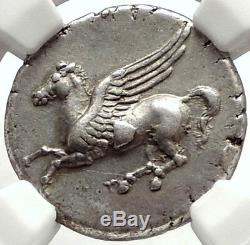
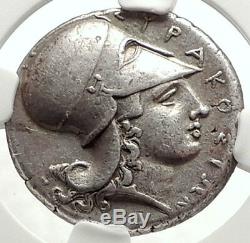
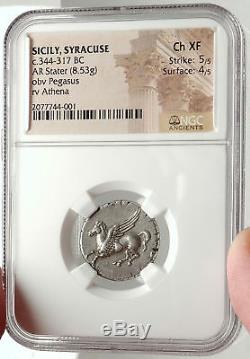
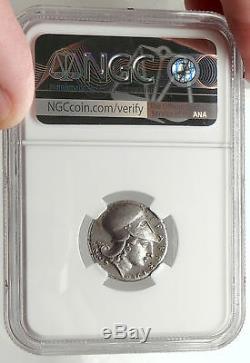
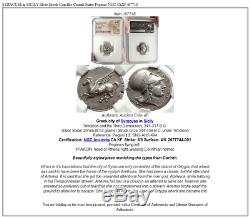

Item: i67718 Authentic Ancient Coin of. Timoleon and the Third Democracy, 344-317 B. Silver Stater 20mm (8.53 grams) Struck circa 344-338 B. Under Timoleon Reference: Pegasi II 2; SNG ANS 494 Certification: NGC Ancients.
Ch XF Strike: 5/5 Surface: 4/5 2077744-001 Pegasos flying left. YPAKOIN, head of Athena right, wearing Corinthian helmet. Beautifully styled piece mimicking the types from Corinth. When in it's foundations that the city of Syracuse only consisted of the island of Ortygia, that island was said to have been the home of the nymph Arethusa.
She had been a chaste, faithful attendant of Artemis. It is said that she got the unwanted attentions from the river god, Alpheios, while bathing in his Peloponnesian stream. Artemis hid her in a cloud in an attempt to save her, however she sweated so profusely out of fear that she was transformed into a stream.
Artemis broke apart the ground to allow her to escape. She found her way to the island of Ortygia where she became the fountain on that island. Pegasus is one of the best known fantastical creatures in Greek mythology. He is a winged divine horse, usually white in color. He was sired by Poseidon, in his role as horse-god, and foaled by the Gorgon Medusa.He was the brother of Chrysaor, born at a single birthing when his mother was decapitated by Perseus. Greco-Roman poets write about his ascent to heaven after his birth and his obeisance to Zeus, king of the gods, who instructed him to bring lightning and thunder from Olympus. Friend of the Muses, Pegasus is the creator of Hippocrene, the fountain on Mt.
He was captured by the Greek hero Bellerophon near the fountain Peirene with the help of Athena and Poseidon. Pegasus allows the hero to ride him to defeat a monster, the Chimera, before realizing many other exploits. His rider, however, falls off his back trying to reach Mount Olympus.
Zeus transformed him into the constellation Pegasus and placed him in the sky. Hypotheses have been proposed regarding its relationship with the Muses, the gods Athena, Poseidon, Zeus, Apollo, and the hero Perseus. The symbolism of Pegasus varies with time. Symbol of wisdom and especially of fame from the Middle Ages until the Renaissance, he became one symbol of the poetry and the creator of sources in which the poets come to draw inspiration, particularly in the 19th century. Pegasus is the subject of a very rich iconography, especially through the ancient Greek pottery and paintings and sculptures of the Renaissance. Personification of the water, solar myth, or shaman mount, Carl Jung and his followers have seen in Pegasus a profound symbolic esoteric in relation to the spiritual energy that allows to access to the realm of the gods on Mount Olympus.In the 20th and 21st century, he appeared in movies, in fantasy, in video games and in role play, where by extension, the term Pegasus is often used to refer to any winged horse. Athena or Athene (Latin: Minerva), also referred to as Pallas Athena , is the goddess of war, civilization, wisdom, strength, strategy, crafts, justice and skill in Greek mythology.
Minerva, Athena's Roman incarnation, embodies similar attributes. Athena is also a shrewd companion of heroes and the goddess of heroic endeavour.She is the virgin patron of Athens. The Athenians built the Parthenon on the Acropolis of her namesake city, Athens, in her honour (Athena Parthenos). Athena's cult as the patron of Athens seems to have existed from the earliest times and was so persistent that archaic myths about her were recast to adapt to cultural changes. In her role as a protector of the city (polis), many people throughout the Greek world worshiped Athena as Athena Polias ("Athena of the city"). Athens and Athena bear etymologically connected names.
Syracuse pronounced, Sicilian: Sarausa , is a historic city in southern Italy, the capital of the province of Syracuse. The city is famous for its rich Greek history, culture, amphitheatres, architecture and association to Archimedes, playing an important role in ancient times as one of the top powers of the Mediterranean world; it is over 2,700 years old.Syracuse is located in the south-east corner of the island of Sicily, right by the Gulf of Syracuse next to the Ionian Sea. The city was founded by Ancient Greek Corinthians and became a very powerful city-state. Syracuse was allied with Sparta and Corinth, exerting influence over the entire Magna Grecia area of which it was the most important city. Once described by Cicero as "the greatest Greek city and the most beautiful of them all", it later became part of the Roman Republic and Byzantine Empire. After this Palermo overtook it in importance, as the capital of the Kingdom of Sicily.
Eventually the kingdom would be united with the Kingdom of Naples to form the Two Sicilies until the Italian unification of 1860. In the modern day, the city is listed by UNESCO as a World Heritage Site along with the Necropolis of Pantalica. In the central area, the city itself has a population of around 125,000 people. The inhabitants are known as Siracusans , and the local language spoken by its inhabitants is the Sicilian language. Syracuse is mentioned in the Bible in the Acts of the Apostles book at 28:12 as Paul stayed there.The patron saint of the city is Saint Lucy; she was born in Syracuse and her feast day, Saint Lucy's Day, is celebrated on 13 December. Syracuse and its surrounding area have been inhabited since ancient times, as shown by the findings in the villages of Stentinello, Ognina, Plemmirio, Matrensa, Cozzo Pantano and Thapsos , which already had a relationship with Mycenaean Greece. Syracuse was founded in 734 or 733 BC by Greek settlers from Corinth and Tenea, led by the oecist (colonizer) Archias, who called it Sirako , referring to a nearby salt marsh.
The nucleus of the ancient city was the small island of Ortygia. The settlers found the land fertile and the native tribes to be reasonably well-disposed to their presence. The city grew and prospered, and for some time stood as the most powerful Greek city anywhere in the Mediterranean. Colonies were founded at Akrai (664 BC), Kasmenai (643 BC), Akrillai (VII century BC), Helorus (VII century BC) and Kamarina (598 BC). The descendants of the first colonist, called Gamoroi , held the power until they were expelled by the Killichiroi , the lower class of the city.
Gelo himself became the despot of the city, and moved many inhabitants of Gela, Kamarina and Megera to Syracuse, building the new quarters of Tyche and Neapolis outside the walls. His program of new constructions included a new theater, designed by Damocopos, which gave the city a flourishing cultural life: this in turn attracted personalities as Aeschylus, Ario of Metimma, Eumelos of Corinth and Sappho, who had been exiled here from Mytilene. The enlarged power of Syracuse made unavoidable the clash against the Carthaginians, who ruled western Sicily.In the Battle of Himera, Gelo, who had allied with Theron of Agrigento, decisively defeated the African force led by Hamilcar. A temple, entitled to Athena (on the site of the today's Cathedral), was erected in the city to commemorate the event. Gelon was succedeed by his brother Hiero, who fought against the Etruscans at Cumae in 474 BC. His rule was eulogized by poets like Simonides of Ceos, Bacchylides and Pindar, who visited his court. A democratic regime was introduced by Thrasybulos (467 BC).
The city continued to expand in Sicily, fighting against the rebellious Siculi, and on the Tyrrhenian Sea, making expeditions up to Corsica and Elba. In the late 5th century BC, Syracuse found itself at war with Athens, which sought more resources to fight the Peloponnesian War. The Syracusans enlisted the aid of a general from Sparta, Athens' foe in the war, to defeat the Athenians, destroy their ships, and leave them to starve on the island (see Sicilian Expedition).
In 401 BC, Syracuse contributed a force of 3,000 hoplites and a general to Cyrus the Younger's Army of the Ten Thousand. Then in the early 4th century BC, the tyrant Dionysius the Elder was again at war against Carthage and, although losing Gela and Camarina, kept that power from capturing the whole of Sicily. After the end of the conflict Dionysius built a massive fortress on the Ortygia island of the city and 22 km-long walls around all of Syracuse. Another period of expansion saw the destruction of Naxos, Catania and Lentini, then Syracuse entered again in war against Carthage (397 BC). After various changes of fortune, the Carthaginians managed to besiege Syracuse itself, but were eventually pushed back by a pestilence.
A treaty in 392 BC allowed Syracuse to enlarge further its possessions, founding the cities of Adrano, Ancona, Adria, Tindari and Tauromenos, and conquering Reggio Calabria on the continent. Apart from his battle deeds, Dionysius was famous as a patron of art, and Plato himself visited Syracuse several times. His successor was Dionysius the Younger, who was however expelled by Dion in 356 BC. But the latter's despotic rule led in turn to his expulsion, and Dionysius reclaimed his throne in 347 BC. A democratic government was installed by Timoleon in 345 BC.
The long series of internal struggles had weakened Syracuse's power on the island, and Timoleon tried to remedy this, defeating the Carthaginians in 339 BC near the Krimisos river. But the struggle among the city's parties restarted after his death and ended with the rise of another tyrant, Agathocles, who seized power with a coup in 317 BC. He resumed the war against Carthage, with alternate fortunes.
He however scored a moral success, bringing the war to the Carthaginians' native African soil, inflicting heavy losses to the enemy. The war ended with another treaty of peace which did not prevent the Carthaginians interfering in the politics of Syracuse after the death of Agathocles (289 BC).
The citizens called Pyrrhus of Epirus for help. After a brief period under the rule of Epirus, Hiero II seized power in 275 BC.
Hiero inaugurated a period of 50 years of peace and prosperity, in which Syracause became one of the most renowned capitals of Antiquity. He issued the so-called Lex Hieronica , which was later adopted by the Romans for their administration of Sicily; he also had the theater enlarged and a new immense altar, the "Hiero's Ara", built. Under his rule lived the most famous Syracusan, the natural philosopher Archimedes. Among his many inventions were various military engines including the claw of Archimedes, later used to resist the Roman siege of 214 BC-212 BC.Literary figures included Theocritus and others. Hiero's successor, the young Hieronymus (ruled from 215 BC), broke the alliance with the Romans after their defeat at the Battle of Cannae and accepted Carthage's support. The Romans, led by consul Marcus Claudius Marcellus, besieged the city in 214 BC.
The city held out for three years, but fell in 212 BC. It is believed to have fallen due to a peace party opening a small door in the wall to negotiate a peace, but the Romans charged through the door and took the city, killing Archimedes in the process. From Roman domination to the Middle Ages.Though declining slowly by the years, Syracuse maintained the status of capital of the Roman government of Sicily and seat of the praetor. It remained an important port for the trades between the Eastern and the Western parts of the Empire. Christianity spread in the city through the efforts of Paul of Tarsus and Saint Marziano, the first bishop of the city, who made it one of the main centres of proselytism in the West. In the age of the persecutions massive catacombs were carved, whose size is second only to those of Rome.
After a period of Vandal rule, Syracuse and the island was recovered by Belisarius for the Byzantine Empire (31 December 535). From 663 to 668 Syracuse was the seat of Emperor Constans II, as well as metropolis of the whole Sicilian Church. Another siege in 878, resulted in the city coming under two centuries of Muslim rule. The capital was moved from Syracuse to Palermo. The Cathedral was converted into a mosque and the quarter on the Ortygia island was gradually rebuilt along Islamic styles.
The city, nevertheless, maintained important trade relationships, and housed a relatively flourishing cultural and artistic life: several Arab poets, including Ibn Hamdis, the most important Sicilian poet of the 12th century, flourished in the city. In 1038, the Byzantine general George Maniaces reconquered the city, sending the relics of St. The eponymous castle on the cape of Ortygia bears his name, although it was built under the Hohenstaufen rule. In 1085 the Normans entered Syracuse, one of the last Arab strongholds, after a summer-long siege by Roger I of Sicily and his son Jordan of Hauteville, who was given the city as count. New quarters were built, and the cathedral was restored, as well as other churches.
In 1194 Henry VI of Swabia occupied Syracuse. He began the construction of the Castello Maniace, the Bishops' Palace and the Bellomo Palace. Frederick's death brought a period of unrest and feudal anarchy. In the struggle between the Anjou and Aragonese monarchies, Syracuse sided with the Aragonese and defeated the Anjou in 1298, receiving from the Spanish sovereigns great privileges in reward. The pre-eminence of baronal families is also shown by the construction of the palaces of Abela, Chiaramonte, Nava, Montalto.
World-renowned expert numismatist, enthusiast, author and dealer in authentic ancient Greek, ancient Roman, ancient Byzantine, world coins & more. Ilya Zlobin is an independent individual who has a passion for coin collecting, research and understanding the importance of the historical context and significance all coins and objects represent. Send me a message about this and I can update your invoice should you want this method.Getting your order to you, quickly and securely is a top priority and is taken seriously here. Great care is taken in packaging and mailing every item securely and quickly. What is a certificate of authenticity and what guarantees do you give that the item is authentic? You will be very happy with what you get with the COA; a professional presentation of the coin, with all of the relevant information and a picture of the coin you saw in the listing. Additionally, the coin is inside it's own protective coin flip (holder), with a 2x2 inch description of the coin matching the individual number on the COA.
Whether your goal is to collect or give the item as a gift, coins presented like this could be more prized and valued higher than items that were not given such care and attention to. When should I leave feedback? Please don't leave any negative feedbacks, as it happens sometimes that people rush to leave feedback before letting sufficient time for their order to arrive. The matter of fact is that any issues can be resolved, as reputation is most important to me. My goal is to provide superior products and quality of service.How and where do I learn more about collecting ancient coins? Visit the "Guide on How to Use My Store". For on an overview about using my store, with additional information and links to all other parts of my store which may include educational information on topics you are looking for. The item "SYRACUSE in SICILY Silver Greek Coin like Corinth Stater Pegasus NGC ChXF i67718" is in sale since Wednesday, April 25, 2018. This item is in the category "Coins & Paper Money\Coins\ Ancient\Greek (450 BC-100 AD)".
The seller is "highrating_lowprice" and is located in Rego Park, New York. This item can be shipped worldwide.
- Certification Number: 2077744-001
- Certification: NGC
- Grade: Ch XF
- Composition: Silver
- Denomination: Stater

